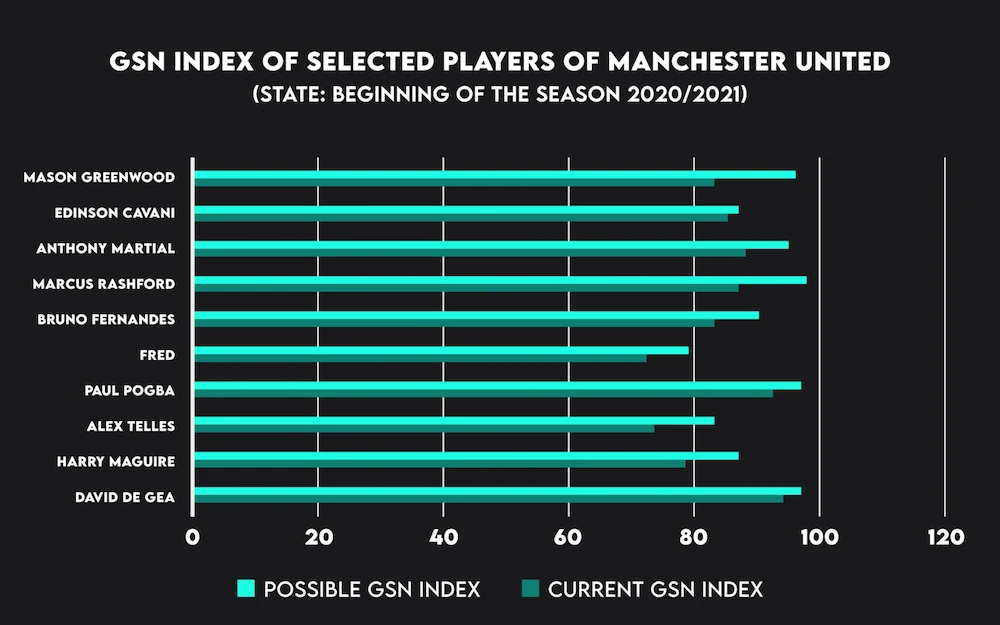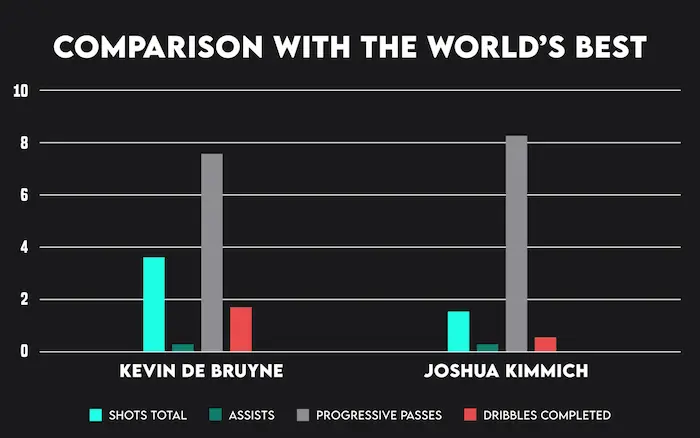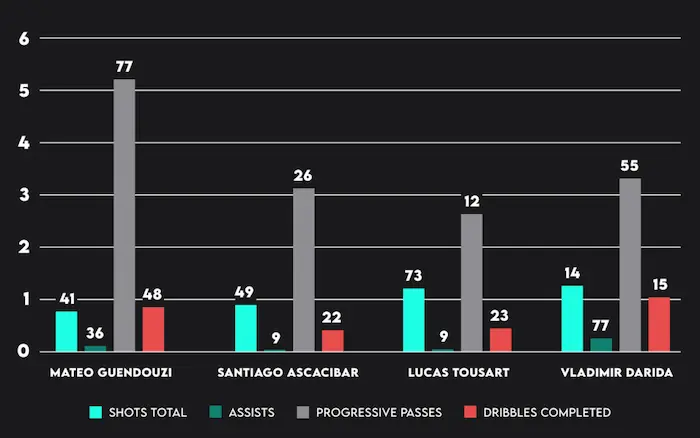One development is certain. The importance of performance measurement and the data collected through it in sports is increasing more and more – especially in soccer. Expected goals or expected assists, passing accuracy, top speed… These values are not only displayed during broadcasts of soccer matches, they are also used by a team’s coaching staff to evaluate performance.
Data is also playing an increasingly important role in talent scouting – through so-called Data scouting in football. We would like to introduce you to the term and show you, by means of a practical example, what influence this can have on the squad planning of a club and how important an established club philosophy is in this context.
What does data scouting mean anyway and what are the benefits?
In contrast to classic scouting, which uses videos or on-site player observation, data scouting is a much more objective method. It involves comparing previously defined characteristics that a potential new recruit should bring with him as input for the team. In the case of a defender, for example, this could be the number of tackles won or balls intercepted per 90 minutes. It is important that the position profiles fit into the club’s system. We will take a closer look at this aspect with a concrete example.
In addition, global data scouting gives a club much more players to look at than if it would send scouts to search in specific areas. Especially in the Corona pandemic, this is only possible under more difficult conditions, which means that data scouting has taken on an even more important role.
Former RB Leipzig sporting director Ralf Rangnick said in 2018, after a less than satisfactory transfer period, “We will now set ourselves up to know every player around the world in the next summer transfer periods – everyone in Germany, everyone in Europe, even in China and Japan or wherever there are football players.”
There can hardly be a more ambitious goal in this fiercely contested competition. In addition to an innumerable number of scouts, this requires data scouting. If any player decides to transfer, his club can use a clever pre-selection process to determine which players are at a similar level and thus adequately replace the departing player. This algorithm allows the scouts to work much more effectively and the club saves time as well as money.
Squad planning is increasingly becoming a game of data. For example, data expert Dustin Böttger founded a company called Global Soccer Networks to address this very issue. His goal was to create a rating system that could objectively evaluate players. The idea for the so-called “GSN-Index” was born. This is composed of the following four pillars with various subcategories to adequately assess a player.
Football-specific characteristics:
- 130 different categories consisting of tactical, technical, mental and physical skills
Football-specific development potential
- Age, susceptibility to injury, soccer education, quality of coaches, youth clubs or performance centers, high school graduation, speaking different languages
Performance
- Basic data during a match such as passes, shots on goal, duels, fouls, duels for headers
Game/Performance level
- All data are set in relation to the level of the opponent team and the league by ELO rating
Taking Manchester United as an example, the assessment of the players is as follows:

How does classic scouting work?
On the homepage of the DFB you can find an observation sheet, as it is usually filled out by scouts during a soccer match to assess the person to be observed. Here it can be noted that a scout can really assess a maximum of four players according to their performance. Thus, a comprehensive assessment of both teams requires at least five scouts.
The observation sheet is structured in such a way that formal aspects such as general information about the game, the observer and the observed player are entered in the left-hand section. In the middle, the player’s skills are assessed. These are subdivided into technical skills, condition/coordination, tactical game ability and personality traits. There are a total of 23 sub-items, each of which can be rated as good, average or poor. On the right side of the sheet, you can also add your own notes on the skills. At the end, it becomes clear whether the player is eligible for further scouting.
Due to the many advantages of data-based squad planning, the question arises why it has not yet arrived at all clubs and why live scouting still plays an important role instead.
Well, there are several reasons for this. Critics say that the human factor is still decisive. There is no substitute for the experience of a scout, and a player cannot be evaluated on the basis of data. Personality tests and personal life stories play a role here. In addition, it can be seen that there is a lack of courage or innovative drive in this country. When it comes to using data scouting, Germany is in the middle of the pack at most. The task must be to get employees to deal more with the topic and gain know-how.
In the end, data scouting should not replace just anyone, but should be a tool to make the work of scouts more successful. On-site game observation should continue to be an integral part.
Practical example Hertha BSC Berlin
After the club had been ranked in the solid midfield for years under their then coach Pal Dardai, an attack on the European places was to be launched from June 2019. In addition to the installation of the new coach Ante Covic, it came to the cooperation with the investor Lars Windhorst. Through his company Tennor, he initially acquired a 37.5 percent stake in Hertha BSC GmbH & Co. KGaA. Windhorst now holds 66.6 percent of the shares, for which he put around 250 million euros on the table. A large part of the money was invested directly in new additions. Thus, for a total sum of about 140 million euros, well-known players such as Tousart, Piatek, Lukebakio, Cunha or Cordoba came.
Two years and five coaches later, the following result can be recorded: Money doesn’t always score goals.
For every club it is essential to deal with the following questions in advance. What transfer policy should be pursued? How do they want to play football? Where do they want to go in the next few years? Only when there are precise ideas about the club’s philosophy should the personnel in the form of coaching staff and players be selected.
Hertha BSC Berlin is characterized by an unbalanced squad planning. Each coach has an individually preferred system of play with different player profiles in mind, making it impossible to provide him with the players suitable for it. Ante Covic preferred a 4-2-3-1 system, Labbadia in turn preferred the 4-3-3 system and Dardai switches back and forth between the 4-2-3-1 and 3-5-2 systems. How is continuity supposed to come about under these conditions?
Especially in central midfield, the club has too similar types of players. With the exception of Guendouzi, they are too defensively oriented.
The following illustration makes this clear. On the vertical axis, the respective actions per 90 minutes of playing time are noted. The respective number above the column is a percentage and additionally describes how good the statistical value is compared to similar player types from the five leagues in Europe. As can be seen, the midfielders are below average in almost all values. The comparison with the world’s best makes this even clearer.
If you want to learn more about such databases, you should stop by the FBref.com site.


Even though there is an oversupply in the midfield, a classic playmaker who can put his teammates in dangerous finishing positions is missing. Cunha would be a candidate, but due to a lack of alternatives, he regularly has to play in a position on the flank that is rather unsuitable for him. The Belgian Lukebakio is not a pure outside player and his teammate Dilrosun is too injury-prone.
After the team has successfully managed to stay in the league, those responsible will have to think carefully about which coach should take over the team in the long term. After that, the team will have to be turned around. After the departures of Ibisevic or Skjebred, there is a lack of leading players. This is where the data-based approach reaches its limits. However, due to the financial possibilities on the part of Lars Windhorst, the club once again has the opportunity to act generously on the transfer market according to their ideas and get rid of players who do not meet international standards.
The potential is undoubtedly there and with Bobic an absolute expert has already been engaged.
Conclusion and outlook
It remains to be said that data scouting, provided it is applied on a solid foundation, can deliver a decisive competitive advantage and will thus be implemented by more and more clubs in the coming years. Especially for clubs like RB Leipzig or Borussia Dortmund, progress in scouting is indispensable so that in the next few years there can also be a soccer champion that does not come from the south. However, this is a process and cannot happen overnight. The crucial thing is that those in charge are fundamentally open to innovations. And who knows, maybe in a few years we’ll see the players on the training pitch wearing virtual reality goggles, which will tell them the best tactical variant. Anything seems possible. The future will show.
I hope this article has given you some insights into data scouting. You can find out more about sports tech on our social media channels.
Feel free to drop by there. Until then, stay sporty and see you in the next blog!